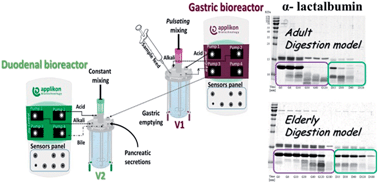Bi-compartmental elderly or adult dynamic digestion models applied to interrogate protein digestibility†
Abstract
The world's population is inevitably ageing thanks to modern progress; however, the development of food and oral formulations tailored to the needs of the elderly is still in its infancy. In vitro digestion models offer high throughput, robust and practically ethics free evaluation of the digestive fate of ingested products. To date, no data have been made publicly available to facilitate the development or application of an in vitro model mirroring the physicochemical conditions of the elderly gastrointestinal system. This study reports the development of a novel and highly bio-relevant in vitro model based on two serially connected bioreactors recreating the dynamic conditions of the adult or elderly alimentary canal. This report and its supplementary material describe in detail the set-up of the system, the applied physicochemical parameters and the development of the controlling software. These are intended to openly depict a versatile platform, which could assist future efforts to develop age-tailored oral formulations. SDS-PAGE analyses of samples collected from the in vitro digestion of β-lactoglobulin, α-lactalbumin and lactoferrin suggest the bioaccessibility of “slow digesting” and “fast digesting” proteins identified in adult models do not necessarily maintain this trait under elderly gastro-intestinal conditions. Overall, this study brings forward a new generic yet advanced model that could facilitate age-tailoring the digestive fate of liquid formulations.


 Please wait while we load your content...
Please wait while we load your content...